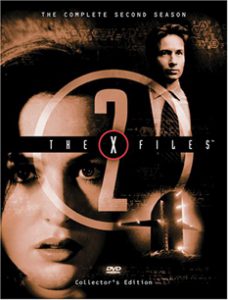Although I’m partial to Season 1 of the “X-Files” because of the lovable, experimental clunkiness of many episodes, Season 2 is pretty darn good also, and it’s certainly more polished. It starts slow, with the first “closing of the X-Files” arc, which means that for six episodes, Mulder and Scully stumble upon X-Files without actually working the X-Files beat.
Also making the early episodes depressing is the fact that Scully is barely in them, because, as all X-Philes know, Gillian Anderson was pregnant.
These dark days did allow for the much-beloved Scully abduction arc; more screen time for Skinner; and the introductions of the awesomely, somewhat hilariously angry X (the replacement for the late Deep Throat) and the Cigarette Smoking Man’s lackey, Krycek.

“The X-Files” Season 2 (1994-95)
Fox, 25 episodes
Showrunner: Chris Carter
Starring: David Duchovny, Gillian Anderson, Mitch Pileggi
Season 2 (1994-95, Fox) features arguably the best mythology episodes of the series (but also some duds, as I’ll explain in my episode rankings) and one of the very best monster-of-the-week hours (and it even happened while the X-Files were closed!).
Here, I rank the episodes from Season 2, the year it became clear that “The X-Files” wasn’t a fad, it was a mainstream hit.
1. “The Host” (episode 2, written by Chris Carter)
Some people like to say “It’s what you don’t see that’s scary” to defend movies or TV shows that cut corners. But a more accurate phrase is “What you do see is scary, but what you imagine after that is scarier.” You gotta start with a creepy creature, and the Flukeman fits the bill.
I love the scene where they flush a section of sewer and the monster is caught in the drain, inches away from the faces of Mulder and the sewer worker. And the scene of the Flukeman standing in the bowels of a porta-potty, looking up. And the idea of him being hauled around in the waste tanker. It’s a wonderfully disgusting episode that earns its status as a classic.
2. “Die Hand Die Verletzt” (14, Glen Morgan and James Wong)
I have a soft spot for yarns about the horrors of high school, so I’ve always liked this one about a cult of devil-worshipping administrators who runs a small-town school. And a substitute teacher who puts even those people’s evil acts to shame.
3. “Irresistible” (13, Carter)
It’s barely an X-File — the only paranormal element is that Donnie Pfaster appears to morph into Satan at random moments — and it’s inexplicable why Scully is inordinately creeped out by this particular bad guy. But the performance by Nick Chinlund is mesmerizingly good; Pfaster is somehow sympathetic even as he lures women to their deaths.
4-5. “Colony” (16, David Duchovny and Carter) and “End Game” (17, Frank Spotnitz)
I think of these as the “Terminator” episodes of “The X-Files,” in a good way. The alien bounty hunter goes around terminating alien-human hybrid clones. He can morph into visages of people he sees, just like the T-1000. And, most notably, Mark Snow’s music heavily riffs from “Terminator.” As a bonus, we see Mulder’s sister Samantha — actually a bunch of clones, but close enough — for the first time, not to mention Mulder’s mom and pop, and this was still at a time when the mythology was fresh rather than repetitive.

6. “One Breath” (8, Glen Morgan and Wong)
The Lone Gunmen analyze Scully’s cells and determine she is dying. And then later she is fine, without explanation. The episode should be dismissed as one giant cheat, but I love it anyway and think it’s the most emotional episode of the series up to this point. This is a case of craftsmanship — acting, editing, music — turning a mediocre script into a great finished product.
7. “Red Museum” (10, Carter)
Those Wisconsin vegetarians with the white robes and red turbans are the most visually evocative of all the cult members “The X-Files” introduced. The episode itself is good, too, as M&S insinuate themselves into a small-town conflict between economics and religion, and then it surprises us with mythology — the guy who killed Deep Throat is bumping off people involved with producing genetically enhanced cattle. Up till this point, it was either MOTW or Mythology, so it was a neat twist to see both in one episode.
8. “3” (7, Chris Ruppenthal, Glen Morgan and Wong)
After Scully is abducted — by aliens or the government, or both — but before she returns, we get one episode where the X-Files are reinstated and Mulder goes to investigate the case. There’s a nearby forest fire that doesn’t play into the plot; these so-called vampires can come back to life without explanation; and even though this should be an acting showcase for David Duchnovny (trivia time: this is the only episode without Gillian Anderson), Mulder just comes off as dour and tired.
And yet I dig this episode because it tried, and in terms of the emotional pacing of the series, it needs to exist. It’s a successful failure, in a way.
9. “F. Emasculata” (22, Carter and Howard Gordon)
Here’s another example of MOTW (or rather, disease of the week) combined with mythology (a pharmaceutical company uses an unsuspecting prison populace as test subjects). The incinerator room where the lab-coated bad guys burn the infected corpses is a classic setting.
10. “Anasazi” (25, Duchovny and Carter)
This season-ending cliffhanger is actually more of a great character piece than a great mythology piece. Mulder is so angrily obsessed with uncovering the cover-up — in this case, that the government has known for years that ETs exist — that he almost gets himself killed, captured or tricked into being framed more than once.
It’s Scully who sees how the villains are operating and keeps a level head, making this a definitive episode of why their partnership works. Bonus points: This is the ep where Mulder calls the CSM a “black-lunged son of a b****.”
11. “Sleepless” (4, Gordon)
Ex-soldiers who haven’t slept in 24 years due to a military medical experiment start being killed off. That’s one of the most creative ideas from the early seasons. Also, Krycek is introduced here as Mulder’s new partner, and up until the final scene where he’s revealed as the CSM’s toady, he actually seems like a decent guy. I even feel for him a bit as Mulder repeatedly kicks him to the curb.
12. “Dod Kalm” (19, Gordon and Alex Gansa)
Mulder and Scully start rapidly aging on a ghost ship. In my opinion, the makeup effects aren’t as terrible as many people claim. The dead, rusting ship is an evocative setting, and this is a rare ep to take place outside the United States — the sea off Norway, in this case. Also, Lydecker from “Dark Angel” gives a good guest turn.
13. “Soft Light” (23, Vince Gilligan)
Tony Shalhoub, pre-Adrian Monk, has a condition where his shadow vaporizes people. It makes no sense that he hangs out in a train station with soft light in order to keep people safe; couldn’t he stay at home, or in his laboratory?. The twist of Mr. X actually being a bad guy here is unexpected. I still kind of like this episode as a lovable clunker.
14. “Our Town” (24, Spotnitz)
This one has some nicely disgusting imagery, such as a river that runs red due to the runoff of blood from the chicken plant, and the woman who is shot and falls into a vat of chicken byproducts, not to mention the idea of townsfolk who all get a rare brain disease because they’ve been eating their own dead.
15. “Little Green Men” (1, Morgan and Wong)
A lesser example (compared to “End Game” and “Anasazi”) of the lengths Scully will go to — here it’s Puerto Rico — to protect the obsessive Mulder. And so the understated theme of Season 2 is set from the get-go. One oddity of this ep is that the bad guys are seriously trying to kill M&S. But later in the season, the CSM says he wants Mulder alive. And then in the season finale, he tries to kill Mulder. Usually, I think the bad guys aim to confuse Mulder, so it’s weird when they blatantly (but only briefly) try to kill him.
16. “Fearful Symmetry” (18, Steve DeJarnatt)
An invisible elephant trampling people makes for a cool opening teaser. But 44 minutes later, it’s still never explained why these animals are invisible; it’s almost as if the writers forgot to explain it. So I’ll categorize this ep as another clunker I kind of like despite itself.
17. “Blood” (3, Darin Morgan, Glen Morgan and Wong)
People get subliminal messages from appliances to kill other people. It’s not a bad premise, but it’s more weird than creepy, so the tone is off.
18. “Humbug” (20, Darin Morgan)
The first episode written by Darin Morgan, the “X-Files” resident comedy writer, is absolutely adored by fans. Some even rank it as the best episode of the series (or among the best, trailing other Morgan scripts). I appreciate the way he shows us that an X-File can be weird rather than scary — in this case, a guy’s detachable twin rampages through a circus sideshow community. However, I’m an “X-Files” fan because of the scary stuff. It’s just a matter of personal taste; no offense is intended.
19. “Excelsis Dei” (11, Paul Brown)
A standard X-File about a haunted old-folks home.
20. “Aubrey” (12, Sara Charno)
A standard X-File about a murderer reincarnated through his unwitting granddaughter.
21. “The Calusari” (21, Charno)
A standard X-File about a boy who is possessed by the Devil. It’s like a less-scary, less-sensible “Exorcist.”
22. “Fresh Bones” (15, Gordon)
A standard X-File about voodoo and dead people being brought back to life. Along with “3” and “Fearful Symmetry,” this is one of those episodes that doesn’t even bother to venture an explanation of how the impossible is possible.
23-24. “Duane Barry” (5, Carter) and “Ascension” (6, Brown)
The former proves that “The X-Files” can do a hostage drama just fine and the latter proves it can do a chase story just fine. But I like my “X-Files” to feature X-Files, thank you very much, so this mythology two-parter doesn’t rank among my personal favorites.
25. “Firewalker” (9, Gordon)
It’s notable for being the first episode where Mulder and Scully are reunited on the X-Files beat, so that should be reason enough to celebrate it. However, the volcano setting, which should be deliciously evocative, doesn’t ring true.
And the idea of a dangerous silicon-based life form, which is right in the “X-Files'” wheelhouse, feels like a lift from the Season 1 classics “Ice” and “Darkness Falls.” Even the worst episodes of “The X-Files” aren’t worthless, but something has to rank last, and this one simply is not better than any other episode from Season 2.
What are your favorite episodes from Season 2 of “The X-Files”? Share your rankings below.

